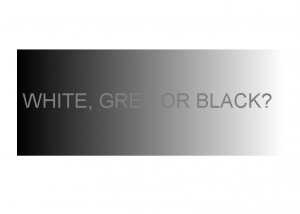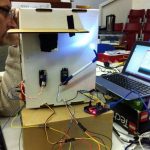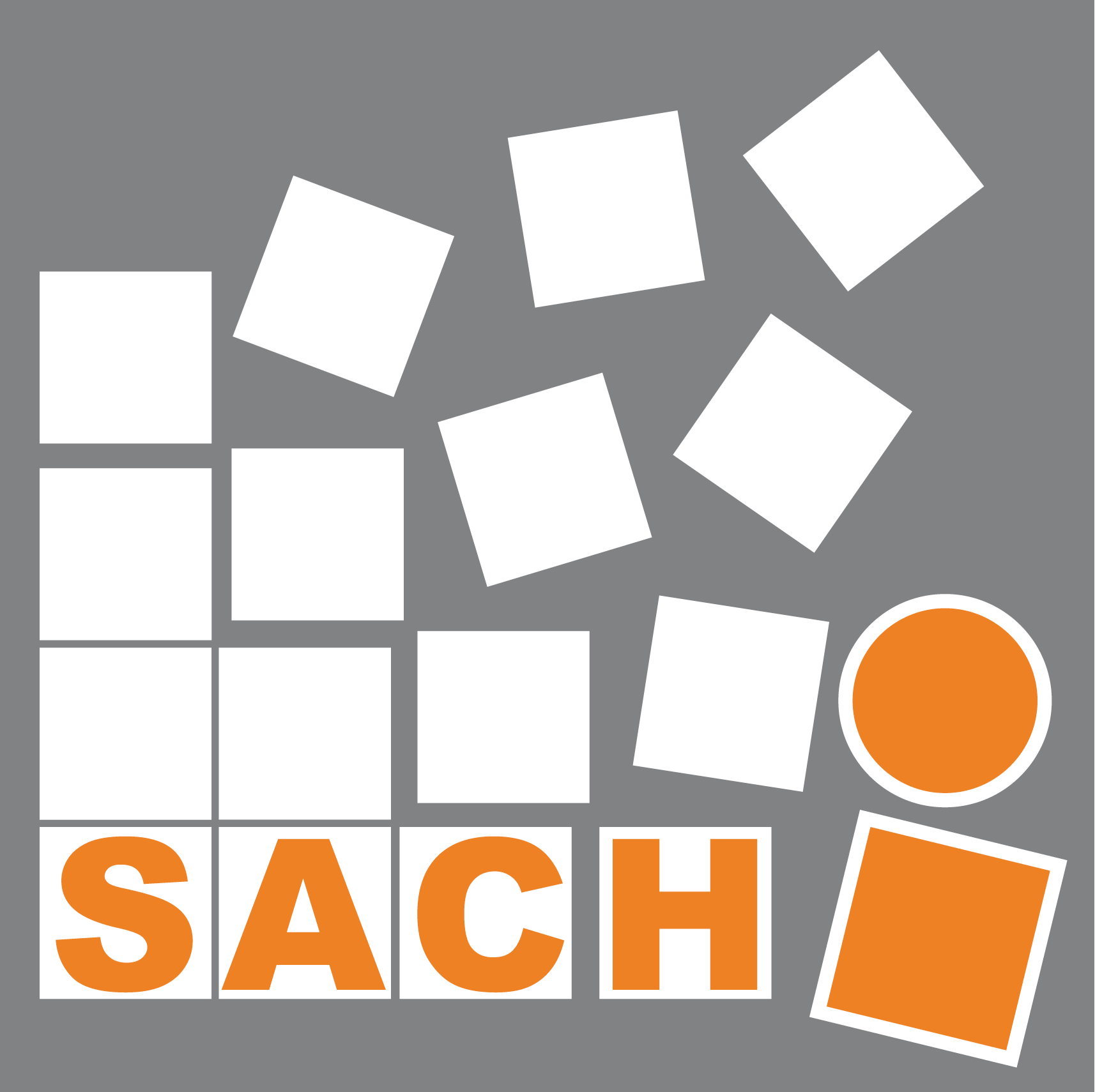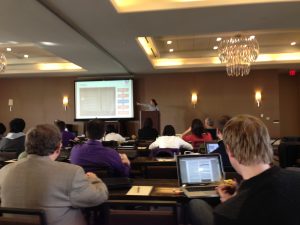<!–Speaker: Olivier Penacchio, University of St Andrews
Date/Time: 1-2pm June 11, 2013
Location: 1.33a Jack Cole, University of St Andrews–>
Abstract:
The perception of such simple visual features as black, greys and white may sound simple. However, the luminance we perceive, also called brightness, does not match the luminance as physically measured. Instead, the perceived intensity of an area is modulated by the luminance of surrounding areas. This phenomenon is known as brightness induction and provides a striking demonstration that visual perception cannot be considered a simple pixel-wise sampling of the environment.
The talk will start with an overview of the classical examples of brightness induction and a quick look at the different theories underlying this phenomenon. We will next introduce a neurodynamical model of brightness induction, recently published*. This model is based on the architecture of the primary visual cortex and successfully accounts for well-known psychophysical effects both in static and dynamic contexts. It suggests that a common simple mechanism may underlie different fundamental processes of visual perception such as saliency and brightness perception. Finally, we will briefly outline potential applications in the arena of computer vision and medical imaging.
* Penacchio O, Otazu X, Dempere-Marco L (2013) A Neurodynamical Model of Brightness Induction in V1. PLoS ONE 8(5): e64086. doi:10.1371/journal.pone.0064086

Bio:
Olivier Penacchio is a postdoctoral researcher in the school of Psychology and Neuroscience of St Andrews University. He is currently working on the perception and evolution of counter-shading camouflage. His background is in pure mathematics, algebraic geometry, and he is a recent convert to the area of vision research.
News
<!–Speaker: Dr Kristian Wasen, University of Gothenberg
Date/Time: 12-1pm Wed May 22, 2013
Location: 1.33a Jack Cole, University of St Andrews,(directions)–>
Abstract:
Dr Kristian Wasen will be presenting his recently published paper co-authored by Meaghan Brierly. Emerging multidimensional imaging technologies (3D/4D/“5D”) open new ground for exploring visual worlds and rendering new image-based knowledge, especially in areas related to medicine and science. 3D imaging is defined as three visual dimensions. 4D imaging is three visual dimensions plus time. 4D imaging can also be combined with functional transitions (i.e., following radioactive tracer isotope through the body in positron emission tomography). 4D imaging plus functionality is defined as “5D” imaging. We propose the idea of “visual touch”, a conceptual middle ground between touch and vision, as a basis for future explorations of contemporary institutional standards of image-based work. “Visual touch” is both the process of reconciling the senses (human and artificial) and the end result of this union of the senses. We conclude that while new multi-dimensional imaging technology emphasises vision, new forms of image-based work using visual materials cannot solely be classified as “visual”.
Bio:
Dr. Kristian Wasen is working as a postdoctoral fellow at the University of Gothenburg in Sweden. He holds two bachelor degrees in Social Psychology and Industrial Management from the University of Skovde, Sweden, and he earned a master’s degree and a Ph.D. degree in Business Administration from the School of Business, Economics and Law in Gothenburg. His current research interests include health care robotics, technology’s social and professional impact, organisational design, evaluation of usability, user acceptance, and efficient human-robot interaction.
<!–Speaker: Vinodh Rajan, University of St. Andrews
Location: 1.33a Jack Cole, University of St Andrews–>
Abstract:
Human handwriting is a process that often generates variable output. Scripts generally begin with characters possessing consistent shape. But the effects of variations tend to accumulate and modify the scripts’ appearance over time. The talk will start with a brief overview of scripts and related concepts. Then the example of the Brahmic family of scripts will be addressed, and in particular the variations that led to their development.This will be followed by a general introduction to handwriting modeling methods along with techniques such as trajectory reconstruction, stroke segmentation and stroke modeling. There will further be a discussion of methods and techniques to model and analyze development of scripts, with prospective applications, and lastly there will be a demo of what was achieved so far.
Bio:
Vinodh Rajan is a PhD student based within the School of Computing, here at the University of St. Andrews. Read more about Vinodh here.
<!–Speaker: Kyle Montague, University of Dundee
Date/Time: 1-2pm May 14, 2013
Location: 1.33a Jack Cole, University of St Andrews–>
Abstract:
Touchscreens are ever-present in technologies today. The large featureless sensors are rapidly replacing the physical keys and buttons on a wide array of digital technologies, the most common is the mobile device. Gaining popularity across all demographics and endorsed for their superior interface soft design flexibility and rich gestural interactions, the touchscreen currently plays a pivotal role in digital technologies. However, just as touchscreens have enabled many to engage with digital technologies, its barriers to access are excluding many others with visual and motor impairments. The contemporary techniques to address the accessibility issues fail to consider the variable nature of abilities between people, and the ever changing characteristics of an individuals impairment. User models for personalisation are often constructed from stereotypical generalisations of the similarities of people with disabilities, neglecting to recognise the unique characteristics of the individuals themselves. Existing strategies for measuring abilities and performance require users to complete exhaustive training exercises that are disruptive from the intended interactions, and result in the creation of descriptions of a users performance for that particular instance.
This research aimed to develop novel techniques to support the continuous measurement of individual user’s needs and abilities through natural touchscreen device interactions. The goal was to create detailed interaction models for individual users, in order to understand the short and long-term variances of their abilities and characteristics. Resulting in the development of interface adaptions that better support interaction needs of people with visual and motor impairments.
Bio:
Kyle Montague is a PhD student based within the School of Computing at the University of Dundee. Kyle works as part of the Social Inclusion through the Digital Economy (SiDE) research hub. He is investigating the application of shared user models and adaptive interfaces to improve the accessibility of digital touchscreen technologies for people with vision and motor impairments.
His doctoral studies explore novel methods of collecting and aggregating user interaction data from multiple applications and devices, creating domain independent user models to better inform adaptive systems of individuals needs and abilities.
Alongside his research Kyle works for iGiveADamn, a small digital design company he set up with a fellow graduate Jamie Shek. Past projects have included iGiveADamn Connect platform for charities, Scottish Universities Sports and the Blood Donation mobile apps. Prior to this he completed an undergraduate degree in Applied Computing at the University of Dundee.
<!–Speaker: Patrick Olivier, Culture Lab, Newcastle University
Date/Time: 1-2pm May 7, 2013
Location: 1.33a Jack Cole, University of St. Andrews–>
Abstract:
The purpose of this talk will be to introduce Culture Lab’s past and current interaction design research into digital tabletops. The talk will span our interaction techniques and technologies research (including pen-based interaction, authentication and actuated tangibles) but also application domains (education, play therapy and creative practice) by reference to four Culture Lab tabletop studies: (1) Digital Mysteries (Ahmed Kharrufa’s classroom-based higher order thinking skills application); (2) Waves (Jon Hook’s expressive performance environment for VJs); (3) Magic Land (Olga Pykhtina’s tabletop play therapy tool); and (4) StoryCrate (Tom Bartindale’s collaborative TV production tool). I’ll focus on a number of specific challenges for digital tabletop research, including selection of appropriate design approaches, the role and character of evaluation, the importance of appropriate “in the wild” settings, and avoiding the trap of simple remediation when working in multidisciplinary teams.
Bio:
Patrick Olivier is a Professor of Human-Computer Interaction in the School of Computing Science at Newcastle University. He leads the Digital Interaction Group in Culture Lab, Newcastle’s centre for interdisciplinary practice-based research in digital technologies. Their main interest is interaction design for everyday life settings and Patrick is particularly interested in the application of pervasive computing to education, creative practice, and health and wellbeing, as well as the development of new technologies for interaction (such as novel sensing platforms and interaction techniques).

We are looking for participants willing to participate in an experiment on depth perception using a gaze contingent display.
Details of the study:
- Sessions: One session of about 45 minutes.
- Task: Use a gaze contingent display to perceive objects in a 3D scene.
- Location: School of Psychology, Room 1.36
- Times: 6.5.2013 – 19.5.2013, Mo to Fr from 9.00 to 18.00
- Reward: £5 Amazon voucher per session
- Contact: If you are interested, please send an e-mail to: mm285@st-andrews.ac.uk
- Supervisor: Dr. Miguel Nacenta
<!–Speaker: Maria Wolters, University of Edinburgh
Date/Time: 1-2pm April 2, 2013
Location: 1.33a Jack Cole, University of St Andrews–>
Abstract:
In this talk, I will give an overview of recent work on reminding and remembering that I have been involved in. I will argue two main points.
– Reminding in telehealthcare is not about putting an intervention in place that enforces 100% adherence to the protocol set for the patient by their wise clinicians. Instead, we need to work with users to select cues that will help them remember and that are solidly anchored in their conceptualisation of their own health and abilities, their life, and their home.
– When tracking a person’s mental health, the stigma of being monitored can outweigh the benefits of monitoring. We don’t remember everything perfectly – if we did, that would be pathological. But this is a problem when we’re asked to report our own feelings, activity levels, sleeping patterns, etc. over a period of several days or weeks, which is important for identifying mental health problems. Is intensive monitoring the solution? Only if it is unobtrusive and non-stigmatising.
I will conclude with a short discussion of the EU project Forget-IT that started in February 2013 and looks at contextualised remembering and intelligent preservation of individual data (such as a record of trips a person made or photos they’ve taken) and organisational data (such as web sites).
Bio:
Maria Wolters is a Research Fellow at the University of Edinburgh who works on the cognitive and perceptual foundations of human computer interaction. She specialises in dialogue and auditory interfaces. The main application areas are eHealth, telehealthcare, and personal digital archiving. Maria is the Scientific coordinator of the EU FP7 STREP Help4Mood, which supports the treatment of people with depression in the community, and is a researcher on the EU FP7 IP Forget-IT, which looks at sustainable digital archiving. She used to work on the EPSRC funded MultiMemoHome project, which finished in February
On Thursday morning Jakub presented the full paper Subtle Gaze-Dependent Techniques for Visualising Display Changes in Multi-Display Environments by Jakub Dostal, Per Ola Kristensson and Aaron Quigley. You can read more about this work on its on designated project page: Diff Displays.
Jakub also participated in the IUI Doctoral Consortium and as a Student Volunteer for the conference. Per Ola Kristensson is a member of the Senior Programme Committee for IUI 2013.
The Tiree Tech Wave (TTW), is run twice a year, and is billed as ‘a hands-on making and meeting event ‘. This Spring, thanks to SICSA funding, SACHI member Anne- Marie Mann was given the privilege of attending.
The Tiree Tech Wave (TTW), organised by Alan Dix and Graham Dean, those who participate are lured by the promise of time to step out, to experiment, play, make things with others and discuss what brings us all together – our new digital maker culture.
The first challenge to all participants of the Tech Wave is getting to Tiree, a small island off the west coast of Scotland. The short flight from Glasgow challenges even the most intrepid participants and appears to be a rite of passage. For the duration of the stay Tech Wavers ask ‘Did you come in the tiny plane?’ a feat of pure courage that bonds us all to Tiree and its inhabitants.
Safe and sound on the island, it’s straight down to business. The Tiree Rural Centre becomes home to the 30+ participants of TTW5. This year, saw an eclectic mix of people from across the country enjoying the island and the projects they worked on. This was an exciting opportunity to meet a wide range of people and develop projects and ideas with them.
Whilst everyone was busy working away, I had the pleasure to work on a project with Ruth Aylett, from Heriot Watt University and Steve Forshaw, from HighWire at Lancaster University . The project was based on an art installation by Gordon Pask called Colloquy of Mobiles that had intrigued Ruth. The original artwork, deemed a form of Cybernetic Serendipity was a reactive, computer-based system composed of five large mobiles. Our task was to honour the artwork using only what we could scrounge from the electronic artefacts in front of us. The resultant piece, which we loosely named Cybernetic Fecundity, was run by 3 arduinos, a ‘male’, a ‘female’ and a constant , which represented time and rhythm. Completing the work took time, patience and a lot of ‘iterative design’. For me, it provided a demonstration of design – from conception to realisation, and it’s achievement drew on everyone’s strength and experience and was an excellent learning opportunity.  A video of the project in action can be viewed here.
A video of the project in action can be viewed here.
Other projects such as those brought by Cardiff School of Art and Design, included various wearable technologies, building a 3D printer, and a ceramic representation of its artist with an embedded RFID tag. The University of Lancaster consisted of two contingents of people, those from HighWire and a group from the Catalyst project, working on an app to help raise Autism awareness. Another project worth mentioning was conducted by Alessio Malizia and Alan Chamberlain, who both worked hard to implement a gesture aware table top in the Tiree Rural Centre, using a Kinect and a projecter.
Whilst busy by day, the evenings were a more social affair. The events organised included a meal at the Scarinish hotel, the launch of the Tiree mobile heritage app, and a meal hosted by Marie-Angela, Tim, Will and Sam from Catalyst.
The true success of TTW5 was the fellowship and ingenuity of the participants. The Tech Wave allows a chance for creativity and networking in a relaxed, informal atmosphere that fosters strong bonds between those taken part. On that note I would like to thank everyone involved with my Tiree Tech Wave experience and it is fair to say that I hope to see them all again.
 On the 4th March, the Royal Society of Edinburgh Young Academy of Scotland welcomed 50 new members, among them Dr Per Ola Kristensson acknowledging his contributions to the field of human-computer interaction, and specifically mobile text entry.
On the 4th March, the Royal Society of Edinburgh Young Academy of Scotland welcomed 50 new members, among them Dr Per Ola Kristensson acknowledging his contributions to the field of human-computer interaction, and specifically mobile text entry.
Dr Kristensson, and the 49 other appointees, joins the inaugural 68 members in what is expected to be a limited group of around 150 members. In addition to the special recognition, membership entitles Dr Kristensson to apply for funding from many of the Royal Society’s grants.
SACHI, and the entire School of Computer Science, wishes to congratulate Dr Kristensson on this prestigious honour.


